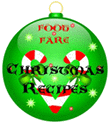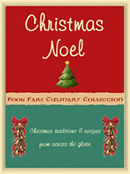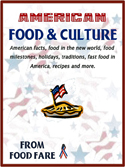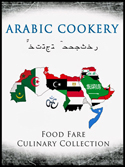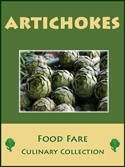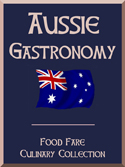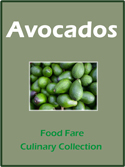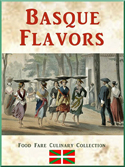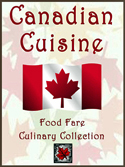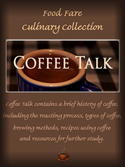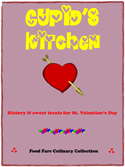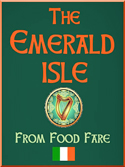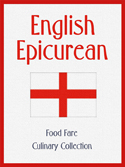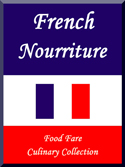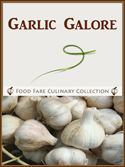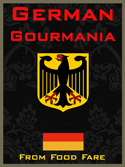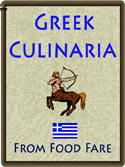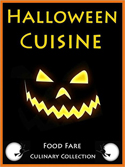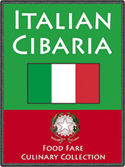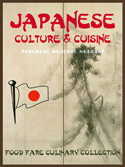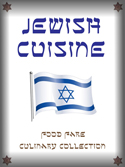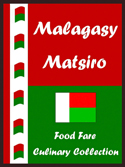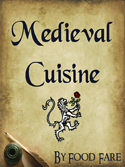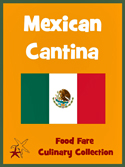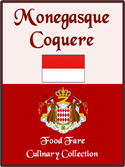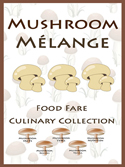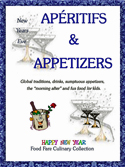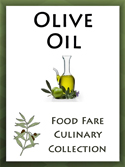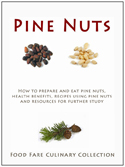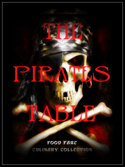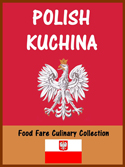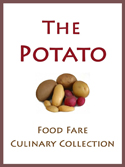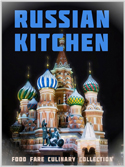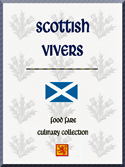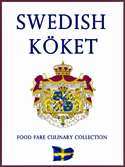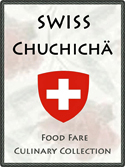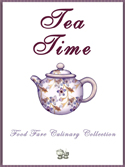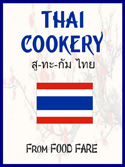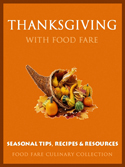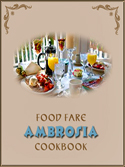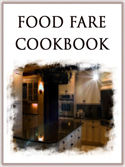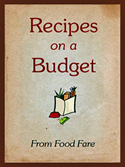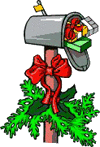|
Contents:
More:
Get the e-book edition of "Christmas Noel" >
Food Fare's Culinary Collection offers an exclusive selection of
more than three dozen titles in Kindle, Kobo, Nook and Adobe Digital
Editions.
The books include information about the food and culture of different countries across the globe, holidays and food-specific topics. They also contain history, food traditions, lifestyle and dishes native to various countries, as well as authentic recipes, words and phrases in the native tongue of the subject, along with food terms. Learn more >
Food Fare's collection of e-cookbooks keeps growing - so take your pick and get cooking!
Social Media:
Shenanchie's blog:
Contact Food Fare:
|
Christmas Traditions
While certain Christmas traditions in other countries are as similar to the ones observed in the United States, each nation has its own variations.
Take a look at a few of them:
In scenes depicting Christmas, Santa's sleigh is often pulled by white kangaroos. In Sydney, a multi-denomination service is held at St. Mary's Cathedral where there are carols as well as scriptures. Scores of singers from several church choirs come into the cathedral singing Adeste Fideles to start the annual event. "Carols by Candlelight" is another Aussie tradition which started in 1937 and involves carol singing in the days leading up to Christmas. Barbeques and backyard parties are also a common sight during the holidays because of the warm weather.
Traditional Christmas dinner, often eaten outdoors, has its British roots in Australia. Some of the common dishes might include roasted turkey or ham, plum pudding, or the Aussie meringue treat Pavlova, adorned with kiwi and passion fruits. Dinner is quite commonly followed by a visit to the beach.
According to Basque legends, the mythological creature Olentzero visits late on the night of December 24th to deliver presents to children. Olentzero is believed to be a member of a giant race of Basques known as jentillak, who once resided in the Pyrenees. Olentzero is said to be plump and jolly, dressed as a peasant with a beret and charcoal-smudged face.
Street celebrations occur during the holidays in Basque Country, when people are often given chestnuts and wine. Children are abed early on Christmas, leaving their shoes in the middle of the house so Olentzero can fill them with gifts. Typical foods eaten during Christmas in Basque Country include anchovies, Bacalao al Pil Pil (salt cod in garlic sauce), beans, blood sausage, grilled lamb chops, hake with ham, Marmitako (tuna stew), Menestra de Legumbres (vegetable casserole), mushroom pinchos, polvoron (almond candy), Sopa de Invierno (winter sop with eggplant, potatoes and tomatoes), turron (sweet nougats) and txistorra (sausage similar to chorizo).
Traditional Christmas dinner or the midnight meal (reveillon) in Canada usually consists of roast turkey with vegetables, mince pies and pudding with brandy sauce. Other typical holiday foods might include boulettes (small meatballs), duck and goose, rice pudding with almonds, smoked salmon and Tourtiere (pork pie).
Wassailing the "apple tree" is another custom still followed in England, mostly in Hertfordshire and other areas of the West Country. The term derived from Anglo-Saxon England, which literally translates to "be hale." The tradition took place on Twelfth Night (January 17th) as farmers and their families feasted on hot cakes and cider, and then retreated to the fruit orchard for more edibles. A cider-soaked cake would then be laid in the fork of a tree, with more cider splashed on top. The men would fire their guns into the tree, while the rest of those present would bow their heads. The custom is also said to ward off bad spirits from the orchard, and lure good spirits to provide an abundant crop for the following year.
The Yule Log custom was thought to have originated from Scandinavia, but it was once quite an event in England. Families would go out to choose their own Yule Log. The selected wood was covered with ribbons and brought home with a sense of pride. The log was burnt for the Twelve Days of Christmas, while the remaining ashes were saved as kindling for the following year's fire.
Christmas cards were said to have been invented in England by John Calcott Horsley, who printed his card in 1843 at the suggestion of his friend, Sir Henry Cole. The "card" looked more like a postcard with three photographs: one of the typical English family enjoying Christmas, with the others depicting acts of charity. The inscription on the card read Merry Christmas & A Happy New Year to You. One thousand copies were printed, selling at one schilling each.
The Christmas tree is central in English celebrations, but the Kissing Bough was popular beforehand. The bough was simply made out of mistletoe, holly, ivy and other evergreens. It was shaped into a double-hoop, and then decorated with apples, pears, ribbons and lighted candles. As with mistletoe, anyone caught under the bough had to be kissed at once.
Some of the food traditionally served at Christmas in England includes roast turkey and potatoes, mince pies, Yule Logs (prepared with apples, raisins, brown sugar, scotch whiskey and syrup), Christmas pudding (made with raisins, cloves, breadcrumbs, rum, walnuts and fruit), butter shortbread, trifle and fruitcake.
On Christmas Eve, children leave their shoes (sabots) in front of the fireplace in hopes Pere Noel will fill them with presents. In other parts of France, Pere Noel visits children with his companion, Per Fouettard, who is a stern disciplinarian. He keeps track of how each child has behaved in the past year. Children are given their gifts on Christmas Day (other than in the north of France), while adults typically wait until New Years Day to exchange presents. The Christmas tree is not overly popular in France, although the French do make a traditional Yule log-shaped cake called the Buche de Nol, which translates to "Christmas Log."
Older children and adults normally attend midnight church service on Christmas Eve, which is followed by a late supper called Le Reveillon (which means to wake-up or "the first call of the day"). The meal might consist of oysters, sausages, wine, baked ham, roasted fowl, salads, fruits and pastries. However, in different regions of France, the food may vary. In the south of France, pain calendeau (Christmas loaf) is cut crosswise and eaten only after the first part has been given to a poor person. In Alsace, roasted goose is common, while in Brittany buckwheat cakes and sour cream are typically served.
In Burgundy, turkey and chestnuts are eaten. Paris offers up region oysters followed by the Buche de Nol. It is also tradition to leave a candle burning just in case the Virgin Mary passes by.
Christmas Day (Weihnachten) involves church services, gift-giving (bescherung) and dramatized nativity plays (Krippenspiel). In Germany, Christmas is on December 24th (never referred to as "Christmas Eve"). Children often take part in the Christmas calendar, which contains twenty-four doors signifying the days leading to Christmas. The children open one door every day, where they usually find chocolate treats and pictures with a Christmas theme.
Santa is known as Saint Nicholas in Germany. He travels with a rather intimidating assistant named "Krampus." The assistant comes with a sack and rod in hand. Well-behaved children receive a present from the sack, but bad children get a few whips from the rod.
On Christmas Eve, small boys usually sing carols by beating drums and sounding acoustic triangles. As they go from house to house singing "kalanda," they are given figs and almonds. Priests often go from house to house, sprinkling holy water to ward off evil spirits during the celebrations.
During Christmas, Greeks greet one another with "Hronia polla" (many happy years). A popular dessert treat is known as Kourambiethes (Christmas Cookies).
Midnight Mass is an event in Ireland. Afterward, children are often given slices of ham with their bed-time cups of tea. Pubs are usually closed for twenty-four hours starting on Christmas Eve.
A bigger celebration is St. Stephens Day, which falls on December 26th. In some households it was custom to have Christmas pudding followed by a shot of whiskey. It was typically the time when people came visiting as well. Some young people will often dress up in costumes reminiscent of Halloween, and walk around to other homes, singing a song about the wrens (the youths are called "The Wren Boys"). In older times, the custom involved killing a wren after beating it out of the bush, but this practice is no longer tolerated. The "Wren Boys" are given pudding, and then they continue on to the next house.
Typical dishes served during the Christmas holiday (Menu di Natale) might include baccala (salted & dried cod), baked pasta, capon, turkey and vermicelli. La Vigilia Napoletana is a multi-course meal of fish, which can consist of fried or roasted eel and caponata di pesce (fish salad). Other common foodstuffs include candied almonds, cenci (fried pastry with powdered sugar), chestnuts, dried figs, marzipan fruits, Panettone (fruit bread), struffoli (honey pastry) and vegetables. Sweet breads are also popular.
In Italy, Santa is a kind, old witch known as "La Befana." She usually comes dressed in black. Gifts might be exchanged on December 25th, but traditional gift-giving occurs on January 6th (Epiphany).
For most Japanese people, Christmas is celebrated as a holiday devoted to the love of their children. Cities are now decorated. Tinsel and lights are displayed in cafes and dance halls. Trees are adorned with small toys and paper ornaments made of gold, wind chimes and lanterns. The most popular decoration in Japan is the "origami" Swan.
Christmas is the time of year when most Japanese people do things for others. Hospitals are decorated to lift spirits, and children sing carols to patients. Children call Santa "Santa Kurohsu" because he is believed to have eyes in the back of his head so he can watch children all through the year. Also known as "Hoteiosho" (a god in Japanese culture), Santa brings gifts every year on Christmas for the children.
Many parties are held in Japan around Christmas, with December being known as the "bounenkai" (forget-the-year) season. There is also the custom of sending "Oseibo" (end-of-the-year-gift) from business to business. The "business" gifts can consist of beer, fruit, coffee or hams. "Oseibo" are specifically given to pay back favors received during the year.
Santa is known as Dadabe Noely (Grandfather Christmas) in Madagascar. The climate in Madagascar during Christmas is akin to summer weather. However, Noely (Christmas) is celebrated widely by the Malagasy people. Most families attend church services, where joyful singing takes place along with poetry and bible readings. Christmas celebrations can stretch over several months, sometimes lasting from December through March. Oddly enough, Madagascar's national flower is the poinsettia, which does not bloom during Christmas.
Common dishes eaten during the Christmas festivities include Akoho misy Sakamalao (chicken seasoned with garlic and ginger) and Akoho sy Voanio (chicken and rice). Koba is a traditional snack in Madagascar, which is simply a plate of rice with banana and peanuts. Lychee fruit (litchi) is also typical. It is eaten fresh or used to make the alcoholic drink known as Litchel.
Locals have developed literally dozens of ways of preparing rice, which is perhaps the most important food in Madagascar and eaten with nearly every meal. A typical dish on the island is a mound of rice, with a side dish of vegetables cooked in water. Other toppings might include zebu, which is the local beef, as well as spicy curries, pork, chicken, crab, corn, peanuts and potatoes. Fish is also another staple food, along with dishes containing vegetables, veal, fresh fruits and nuts.
The people of Mexico share many traditions with the Spanish. One is called "La Posada," which is a religious ceremony re-enacting the story of Joseph and Mary before the birth of Jesus.
Another tradition common through the holidays is called "Pastorelas," which are simply "Shepherds Plays" staged by both professional and amateur groups. In most Mexican homes, the principal decoration is "el Nacimiento" (Nativity Scene), where the focus is on a stable made out of clay or plaster. The display may also have an angel ("Los Reyes Magos," which means the Magi). Holiday festivities culminate on "Noche Buena" (Christmas Eve), with the celebration of the late-night Rooster's Mass ("Misa de Gallo").
The Poinsettia plays a big role during the holidays. The beautiful flower is called "Flor de Noche Buena" (Christmas Eve Flower). It was named after Dr. Joel R. Pointsett, a diplomat who served as Minister to Mexico in the 1820s.
Afterward, everyone would wet their lips on the glass of wine and settle into their meal. The main dish was "Brandamincium" (a dish of salt cod with oil and cream); "Cardu" (cardoon in wine sauce); Barbagiuans (stuffed fritters) and "Fougasses" (biscuits sprinkled with aniseed colored red and white, and flavored with rum and orange water).
The first star of Christmas Eve night was given the name Gwiazdka (little star) in remembrance of the star of Bethlehem. On this night, most Polish people watch the sky for signs of the first star. The moment it appears, everyone exchanges greetings and good wishes. Families come together for the most important meal of the holiday, called Wigilia (Christmas Eve supper). The word Wigilia is derived from the Latin word vigilare, which means to "keep watch" or "keep vigil." It is considered bad luck to have guests for the Wigilia, as it is strictly a family affair.
Food at the Wigilia does not include meat (to signify one must always give up something in order to gain), but it does involve twelve courses to depict the twelve apostles. Fish is typically the main dish (usually herring, carp or pike). Other traditional items include poppy seed cakes, beet (borscht) soup, mushroom soup, prune dumplings, herring in sour cream, Christmas honey cookies, sauerkraut with wild mushrooms or peas, dried fruit compote, noodles with poppy seeds and Pierogi (dumplings) stuffed with sauerkraut and mushrooms.
A white tablecloth is used for the Christmas Eve supper. No one is supposed to leave the table during the meal. Dishes with poppy seeds are always included as a symbol of peaceful sleep, and honey for sweetness and contentment. Supper on Christmas Day, however, is usually more relaxed. People may rest or visit relatives. Very little cooking is done; instead meals are served cold or reheated. Typical fare might be cold turkey with cranberry sauce, goose with cabbage, a cold vegetable-potato salad, or clear hot beet soup. Bowls of nuts and dishes with candy are also placed on tables.
In 1991, Russia celebrated its first official Christmas after the end of the suppression. It was a novelty for the majority of Russians since public celebrations had been forbidden after the revolution in 1917. Showing the powerful influence of Christmas, it is now a legal holiday. For most Russians, Christmas represents a return to their religion, roots and culture.
Christmas in Russia is now very popular, where Santa is known as "St. Nicholas" or "Baboushka." Legend tells of Prince Vladmir in the 11th century, who traveled to Constantinople to be baptized. He returned to Russia full of the tales of St. Nicholas of Myra. Nicholas is a name most common for Russian boys, and many Eastern Orthodox churches have been named for the saint as well.
The Feast of Saint Nicholas was actually celebrated on December 6th for many years, but was suppressed after the communist revolution. It returned after the fall of communism. Before the revolution, a figure known as "Baboushka" would deliver gifts to children.
Most Russians who are also Christian belong to the Eastern Orthodox Church, where it is custom to fast until after the first church service on Christmas Eve. On Christmas Day, carols and hymns are typically sung ("kolyadki"). People gather in churches with Christmas trees ("yelka"), colored lights and floral arrangements. Russian holiday food includes many meat dishes, with suckling pig and goose being the most popular.
New Year's has remained a more popular holiday in Russia, although Christmas has made a remarkably strong comeback.
On Christmas Day, families typically open their gifts together and then enjoy a substantial lunch, usually consisting of turkey with all the trimmings, wine or champagne, oatcakes (Bannocks) and pudding. Tea time involves bread and butter with smoked salmon.
However, Scottish people tend to reserve the biggest celebrations for New Year's Eve (also known as Hogmanay). One of the more quaint customs is "first-footing," which usually takes place just after midnight. People try to be the first person to cross the threshold of a friend or neighbor. The practice also involves symbolic gift-giving, such as black bun fruit cakes, coal, salt, shortbread and whisky. Other Hogmanay customs include fireball swinging, blessings for livestock and households, dance parties and the singing of "Auld Lang Syne" (inspired by the poem written by Scots native Robert Burns).
The Spanish create elaborate Nacimiento (nativity scenes) during Christmas, which sometimes include figures of bullfighters along with religious characters. There are Christmas markets scattered throughout villages and cities in Spain, with offerings such as fruits, flowers, marzipan, candies and decorations. Small oil lamps are kept burning in village windows in many places.
At midnight, ringing bells indicate the time for La Misa Del Gallo (The Mass of the Rooster, also known as Midnight Mass). The most remarkable of the services is said to be held at the monastery of Montserrat in the mountains near Barcelona. The bringer of gifts is not Santa in Spain; instead the Three Wise Men deliver presents to the children. On the Eve of Epiphany (January 5th), children place their shoes on the doorstep. In the middle of the night, the Three Wise Men will pass and leave gifts.
Christmas dinner is typically eaten after midnight, and is very much a family affair. The most typical part of the feast is called Pavo de Navidad (Christmas turkey). After the large meal, families often gather together around the Christmas tree and sing carols, the celebrations often lasting until the wee hours of the morning. The practice falls in line with an ancient Spanish saying known as: Esta noche es Noche Buena, Y no es noche de dormir ("This is the good night, therefore it is not meant for sleep").
Although Sweden is home to the reindeer, Santa Claus was not always among the natives. The traditional Christmas "visitor" was the Hustomten (also called nisse, translated to gnome). The Hustomten was a short, good-humored sprite with a long beard and a tasseled red cap. Swedes believe the Hustomten to be thousands of years old. On Christmas Eve, people left him a dish of rice porridge with cinnamon on the doorstep. The ritual of Santa Claus has gained popularity in Sweden, however, and Swedish children often write to "Father Christmas" at his home in Lapland. The Swedish version of Santa does not place gifts in stockings, but gives them to the children directly.
Santa Claus in Switzerland does not come from the North Pole but rather Schwarzwald (the black forest in Germany). Santa does not materialize on Christmas Day (having already appeared on December 6th). Instead, the Christkind (Christ-Child) is evident in many celebrations. The Christkind is an angel dressed in white who grants the wishes of children. No one has seen the Christkind, of course, but people still believe.
On December 24th, Swiss families decorate trees in the evening. When a bell is rung, everyone hurries to the Christmas tree to open their gifts. The windows are also opened, when children are told to look to see if the Christ-Child has departed.
In the village of Halleil on Christmas Eve, Wienectchind (Christmas Child) parades through town wearing a white robe and carrying a lantern. Six young girls follow her. They visit families, sing carols and give cakes to other children. Father Christmas (as Santa is known in Switzerland), delivers gifts to the boys, while his wife Lucy (so named after St. Lucy, whose feast day is December 13th), gives gifts to the girls. In Zurich, Santa visits in a special tram and gives the children a ride through the city, singing carols with them and giving out sweets from a basket.
There are many Santa Claus societies in Switzerland (Samichlaus-Gesellschaft). People book Santa for parties or celebrations in private homes. Santa has two helpers in Switzerland: one is a black knight who does not speak, and the other is a white angel who carries a big book. The book contains details of the children's behavior through the year, and whether they have been bad or good. Good children receive oranges, tangerines, chocolate, nuts and other treats. In many Swiss families, it is tradition that children put their shoes by the front door. Santa fills the shoes with goodies.
There are popular "treat" foods served in Switzerland during Christmas, enjoyed by the country as a whole: Basler Leckerli (basil cookies), Brunsli (Swiss brownies), Mailanderli (also known as butter or Milano cookies), Nusstorte (a nut cake well loved in the canton of Graubunden) and Zimtsterne (cinnamon cookies).
Santa Claus comes on Christmas Eve and delivers presents under the tree. Most children leave a snack for Santa, typically cookies and milk. Christmas trees are very popular in the States. They are decorated with colored lights, ornaments and foodstuff. Stringing colored lights on houses is also typical. Sometimes neighbors try to outdo one another each year by adding more and more Christmas lights.
The ideal Christmas is one blanketed in snow, but this is not possible in U.S. cities such as Los Angeles (California) and Miami (Florida), where climates are notoriously warm and dry. However, Denver (Colorado), Salt Lake City (Utah), Jackson Hole (Wyoming), Missoula (Montana), Gary (Indiana), and eastern cities such as New York and Washington D.C. get more than their share of snowfall, and then some.
Some specific traditions across the United States come in the form of carol-singing on Beacon Hill in Boston. In New York City, shoppers watch skaters beneath the Christmas tree at Rockefeller Center. In Chicago, an enchanted forest of international trees and three "crèche's" are decorated by the city's cultural community and are on public show through the New Year. In Bethlehem, Pennsylvania the season starts off with a Christmas Market while city buildings display a single candle in each window. In St. Augustine, Florida the historic area of town is draped in white lights. In Hollywood, California there is the annual Parade of Stars. In New Orleans, carolers gather each year in Jackson Square for a large community singing concert. In Fredericksburg, Texas there is a huge German-style Christmas market.
In Washington D.C. the highlight of the Christmas season is the lighting of a large tree south of the White House, with smaller trees around it representing each state. This tree-lighting ceremony began on Christmas Eve 1923, when President Calvin Coolidge pushed a button to light the very first national Christmas tree erected on the south lawn of the White House.
Great variety also springs from the food traditions in various states. New England is famous for their Lumberjack Pie (mashed potato crust filled with meats, onions, and cinnamon). Louisiana offers Creole Gumbo (prepared using ham, veal, chicken, shrimp, oysters and crabmeat). In Baltimore, Maryland sauerkraut is served with roasted turkey. The Pennsylvania Dutch offer-up Sand Tarts (crisp sugar cookies), while North Carolina has Moravian Love-Feast Buns (sweet bread made with flour and mashed potatoes). Virginia is proud of their Oyster & Ham Pie. Some of the Southern states specialize in Hominy Grits Soufflé and Whisky Cake (which includes one full cup of 100-proof whisky). New Mexico has Empanaditas (beef pies with applesauce pine nuts and raisins), and Hawaii offers Turkey Teriyaki (turkey marinated and cooked over an outdoor pit).
The holiday season is also the time of "Mari Llywd." The bizarre manifestation is now represented by a man dressed in a sheet carrying a horse's skull, or adorning a fake horse-head. The creature dances around in public and attempts to bite people with the jaws of the horse. If bitten, you must give the creature money.
The Christmas religious service is known as "Plygain" in Wales. It lasts from four in the morning until sunrise on Christmas Day.
Taffy and Christmas pudding are traditional holiday treats in Wales. It is said the pudding must be made by the 25th Sunday after Trinity, prepared with thirteen ingredients to represent Christ and his disciples. Every family member takes turns stirring the pudding with a wooden spoon. Items are sometimes put into the pudding to bring various forms of luck: a silver coin will bring wealth and a ring signifies marriage within the year. Discovering thimbles and buttons foretells the finder remaining single.
|
![]() Christmas Noel ©Food Fare
Christmas Noel ©Food Fare
![]() Webmaster:
Webs Divine
Webmaster:
Webs Divine
![]()

